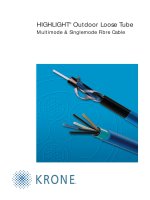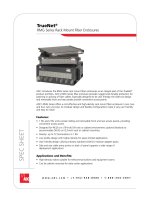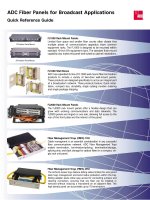Tài liệu Addressing profitability challenges in Advanced Fiber Management for FTTP networks ppt
Bạn đang xem bản rút gọn của tài liệu. Xem và tải ngay bản đầy đủ của tài liệu tại đây (159.61 KB, 4 trang )
WHITE PAPER
Addressing profitability challenges in
Advanced Fiber Management
for FTTP networks
Addressing profitability challenges in
Advanced Fiber Management
for FTTP networks
Advanced fiber management systems incorporate the latest techniques for optimizing access
networks for accessibility and time required to reconfigure, perform maintenance, or troubleshoot
problems. Successful fiber management plays an increasingly important role in eliminating potential
problem areas that can become both costly and time consuming over the life of the network.
The fiber management experts at ADC have spent many years developing these techniques and
providing solutions that match the ever-evolving fiber-to-the-premise (FTTP) network architectures.
This paper will address the latest challenges facing service providers and present practical solutions for
dealing with them – solutions that will save both time and operational expense over the long term.
Passive optical network (PON) architectures are designed with no redundant paths, therefore, there is
no network protection. Normally, any maintenance requirement within the PON requires taking the
network out of service until the problem is resolved. With that in mind, providers need the fastest
possible access to quickly isolate and repair problems, while minimizing outages.
Electronic gear at each end of the PON, basically the optical line terminal (OLT) and the optical
network terminals (ONTs), can communicate with each other. If the OLT loses contact with a single
ONT, it’s logical to assume the problem is between the splitter output and that ONT. If the OLT
loses contact with all the ONTs of one splitter, the problem is between the central office (CO)
and the splitter. However, the electronics at the ends of the PON cannot identify the exact location
of the problem.
The only way to determine the exact location of the problem is to get onto the fiber itself and
perform an optical time-domain reflectometer (OTDR) trace. The need for quick and easy access to
the fibers in a traditional fiber management system is critical – and although there have been many
advances in terms of management, density, and ease of access, the requirement for a technician to
gain access for adds, moves, and testing is still necessary in many FTTP architectures. Let’s look at
some of the challenges this access still poses.
The challenges
As service providers face increasing pressure to be profitable, traditional cable management is often
not enough, particularly in the area of the optical distribution frame (ODF). Increasing revenues
requires decreasing operational costs, and this means reducing technician errors, achieving faster
service turn-up time, lowering overall maintenance expenses, and resolving customer issues promptly.
Many network outages can be traced back to technician error, and a lot of those errors are attributed
to poor record keeping. Contrary to popular belief, record keeping in our industry is often a neglected
area. For instance, knowing where every patchcord is routed requires routing records that are only
as good as the last person who touched them. How important is it to know which patchcord
to disconnect for troubleshooting a fiber? Ask the customer who lost service when the wrong
connection was broken.
Technicians must also deal with cable congestion issues. A 144-port panel has 144 terminations in a
very small footprint, so unless the means are in place for easy identification – and record keeping is
accurate – there will always be potential for human error.
Of course, if the technician cannot easily access the panel, then it becomes even more difficult to
locate the proper connector, increasing the likelihood of errors. It’s easy to see how much time might
be spent just locating the proper connection for service turn-up, maintenance, or troubleshooting.
Withdrawing the wrong connector only adds time, expense, and aggravation. Therefore, the
optimal solution for preventing the possibility of technician error is one that minimizes the need
for technicians to access the network.
Reducing overall operational expenses will require a reduction in the work actually performed
at the ODF location. With many traditional systems, the amount of labor required for identifying
and accessing a particular connector is significant. Cable congestion following a recent push for
higher density systems, coupled with decommissioned patchcords (unused and left in place) and
an inexperienced technician can further compound the problem.
Once a problem has been identified and isolated, a truck roll – with all the required test equipment
and technicians on board – must be dispatched. This may be the most significant operational cost
incurred by FTTP networks. These truck rolls are not only required following fault isolation, but also to
keep pace with network requirements through the demands of the end customer.
To address these challenges, ADC has developed advanced ODF solutions that incorporate additional
functionality in their cable management solutions that traditional systems may be lacking. Service
providers who take initial steps to address challenges in today’s ODF systems will increase profitability,
save maintenance costs, and provide top-notch customer service for the future.
Page 3
Out with the old
Traditional ODF solutions are basically configured with a
demarcation/interface point between the OSP fibers and the
network elements, basically a crossconnect patchcord. These
systems have a lot of inherent value. Purchasing and deploying
the OSP fiber is a significant investment for any carrier; so they
need to get the most possible value out of that investment.
With that in mind, the core functions of the ODF include
allowing both easy access to the fiber network for customer
churn (adds, moves, changes) and centralized test points for
troubleshooting. With the traditional ODF, service providers
have a permanent location for accessing their fiber. The same
is true of each network element – enabling them to connect
any equipment to any OSP with the crossconnect fiber. This
is also where the aforementioned record keeping challenges
become apparent.
The ODF solution, as it is today, is an extremely valuable part
of the network, providing equipment location, easy access,
and permanent port locations. In fact, a service providers’
fiber frame solution is probably one of the most reliable entities
within the network. Once the connectors are plugged in and
the fibers are routed, system failures are rare in the absence
of any external forces.
But as good as today’s ODF systems perform, ADC has
developed several improvements that will address the new
challenges to higher profitability from the network. While still
maintaining the core value of the ODF, service providers can
increase the functionality and find ways to reduce the cost of
operations while improving the test access capability.
In with the new
One way to improve the ODF functionality is to incorporate
optical splitters. The optical splitter is used for many purposes,
such as combining signals and multicasting. Within the ODF,
these devices provide a “window” onto the fiber for testing
and troubleshooting.
Basically, the splitter provides a non-intrusive tap onto the
fiber itself, enabling technicians to run signals through their
test equipment.
With a splitter module, technicians avoid taking a signal out
of service by pulling the patchcord off the frame to plug in an
OTDR. Instead, they can actually plug into the network via the
splitter to monitor the signal without interrupting service.
Additionally, test signals can be launched into the network
by using the optical splitter in reverse as a combiner. However,
when putting these value-added modules (VAMs) into the ODF
system to provide easier fiber access, a technician is still required
to go to the frame, locate the port, set up equipment, and
run the tests. So even though the VAM provides that critical
window into the fiber network, the solution still requires a
lot of time and work for the technician. There is still an even
better way.
Taking the same monitoring window provided by the splitter
VAM, the test equipment is mounted permanently on racks
within the central office (CO). The test equipment is then
connected to an optical switch. All of the monitor ports are also
connected to the switch. With this configuration, a technician
can connect any window port to any piece of test equipment
from a computer in the CO or network operation center (NOC).
The switch makes the desired connection and the technician
runs his OTDR trace, analyzes it, and determines if additional
tests are required. With this remote testing concept, it’s easy
to see dramatic time savings in fault isolation – from hours
to minutes. Not only is troubleshooting time reduced, but
customer service is improved. Instead of being sent into the
field to troubleshoot a problem – requiring a truck roll and
lots of remote equipment – the technician is now sent out
to actually fix the problem. The troubleshooting phase is
already completed.
Advanced ODF applications
These advanced ODF solutions have several vital applications.
One is in traditional network monitoring, such as monitoring
a hand-off or keeping track of critical circuits. For example, a
service provider may have several high-value customers with
service level agreements (SLAs) that guarantee 99.999 reliability.
Providing this high reliability requires the provider to identify any
network issues before they become network outages.
With monitoring ports and test equipment permanently set
up and connected to the switch, these circuits can be cycled
through a testing scenario on a regular basis. For instance, an
OTDR trace can be gathered at regular intervals and compared
with an original trace to determine any potential issues.
Another example might be an area of the network known to
have poor cable management or excessive fiber bending. This
area could be regularly monitored to ensure that attenuation
levels remain constant. The bottom line is that potential
problems can be identified early and dealt with before the
customer’s service is affected.
This could potentially be a service that the provider could
actually sell, adding new revenue streams. With the remote test
and monitoring ODF solution, it now becomes easier to provide
more value-added reliability and monitoring capability services
to customers.
Addressing profitability challenges in advanced fiber management for FTTP networks
Network
Element
OC-x
Equipment
Patchcord
RTM ODF
System
Factory
Terminated
Multi-fiber
Intra
Facility
Cable
OSP
Termination
Panel
Monitor ports connected to test
equipment via N x M Switch
Cross Connect Patchcord
Optical Splitter
10%
90%
Splice
Panel
OSP
Cable
Cable
Entrance
Vault
Equipment
Termination Panel
Equipment Frames
OC-3
Test
OC-48
Test
OC-
192
Test
OTDR
Test
Equipment
Patchcord
10%
90%
WHITE PAPER
Website: www.adc.com
From North America, Call Toll Free: 1-800-366-3891 • Outside of North America: +1-952-938-8080
Fax: +1-952-917-3237 • For a listing of ADC’s global sales office locations, please refer to our website.
ADC Telecommunications, Inc., P.O. Box 1101, Minneapolis, Minnesota USA 55440-1101
Specifications published here are current as of the date of publication of this document. Because we are continuously
improving our products, ADC reserves the right to change specifications without prior notice. At any time, you may
verify product specifications by contacting our headquarters office in Minneapolis. ADC Telecommunications, Inc.
views its patent portfolio as an important corporate asset and vigorously enforces its patents. Products or features
contained herein may be covered by one or more U.S. or foreign patents. An Equal Opportunity Employer
105919AE 2/08 Original © 2008 ADC Telecommunications, Inc. All Rights Reserved
Another application addresses the challenge of testing PON networks. Even though the electronics can diagnose
many of their own issues, if there is a fiber break in the network, neither the OLT nor the ONT can tell you where
the break occurs. Basically, the electronics can only narrow it down to before or after the splitter in the OSP. Beyond
that, a truck roll is usually required to find the exact problem location.
A truck, loaded with all the necessary test equipment, must go to the fiber distribution hub (FDH) or splitter cabinet.
At the cabinet, the technician will set up the OTDRs, power meters, and other necessary equipment to test the
individual fibers. Provided the technician is skilled enough to use and read the test equipment, or even has the
necessary equipment on the truck, this is going to be a high-cost procedure that will likely take hours to restore
subscriber services.
A better solution can be adapted within the CO for fault isolation in the PON portion of the network. It would
involve designating a spare fiber between the CO and FDH as a test fiber with a dedicated port in the cabinet.
In the FDH or splitter cabinet, there are multiple splitters – each serving up to 32 subscribers. However, when the
carrier runs the fiber from the CO to that cabinet, there are generally several spare fibers. Dedicating one of those
fibers for testing purposes enables technicians to have a port on the fiber frame that is a designated test fiber for
that particular cabinet.
Now, when a problem occurs between the FDH and a subscriber, the technician still responds to the cabinet. Only
now, it can be a less-skilled technician who doesn’t need to bring all that test equipment. The technician will simply
route a temporary patch cord to connect the maintenance port to each subscriber fiber. Back at the CO, a more
highly-trained technician, using the permanently mounted test equipment, runs all the tests, identifies the problem,
and relays the “fix” back to the technician at the cabinet.
In this scenario, one highly-trained technician can perform any test from the CO, decreasing the cost of truck rolls.
In fact, test equipment costs are greatly reduced since the need for equipment in every truck is eliminated.
Another benefit of this configuration is in service turn-up. A technician simply hooks up the ONT at the subscriber
premise, then plugs into the maintenance link at the FDH to perform initial testing without having to be on the live
network. Once the link is tested and verified from the CO, the FDH connection can simply be swapped from the
maintenance port to the optical splitter – turning up service much faster.
Finally, this solution also provides easier fault isolation when the problem is determined to be between the CO
and the FDH cabinet and somewhere on the feeder fiber. Traditionally, the process was to send a technician to the
frame, locate the patch panel and port, pull the patchcord, and hook up the appropriate test equipment. As stated
before, this process can be problematic for many reasons, including technician errors, poor record keeping, or cable
congestion – and it also takes time.
However, by taking advantage of the same monitor functionality and using the splitter in reverse as a combiner,
an OTDR trace can be launched onto the feeder fiber without actually going into the CO and rerouting patchcords.
Instead, a quick OTDR trace is performed, fault isolation accomplished, and a technician is dispatched to fix
the problem.
Using a maintenance fiber in the FDH cabinet, a test link is established between every subscriber and the CO.
However, the key is the optical switch. By permanently linking test equipment to the maintenance fibers, easy
access is achieved and testing is accomplished faster –equating to less operational cost and higher profitability.
In summary, there are many access network challenges facing service providers today.
Optimizing the access network for accessibility and decreasing the time required to reconfigure, perform
maintenance, or troubleshoot problems can significantly increase the overall flexibility and functionality of the
network. A well planned advanced fiber management system plays a very important role in eliminating potential
problem areas that can become both costly and time consuming over the life of the network. The techniques
presented in this paper will save both time and operational expense over the long term.
WHITE PAPER









